Luminous Audio Technology Axiom II
Photos: Erik Putens
We are getting ready to move. I hate moving. I mean, I really, really, really hate moving. There are numerous unpleasant things, given the option, I would gladly choose to do over moving. I think moving is a gift given to us by God as a reminder of how to conduct our earthly behavior because if we don’t mind our P’s and Q’s, we’ll be spending eternity somewhere really, really hot and we’ll spend that unending span of time moving. Seriously – that’s how much I hate it. With two jobs and five kids, the moving process has been a slow one for us. Like a two-steps-forward-one-and-a-half-steps-back type process. In an attempt to minimize the amount of crap I actually have to move, I have been trying to weed out some of the stuff I tend to accumulate. During this process I came across my collection of magazines that I published for a number of years – one of which was an audiophile/music magazine called The HI-FI Reader. It’s fun to periodically go back and read the words I wrote. Years after the fact, reading that stuff feels more like reading someone else’s work rather than my own. It was ironic when I came across issue #6 of The HI-FI Reader as it gave me the opportunity to go back and read about the time I spent listening to Luminous Audio’s single input Axiom passive preamp. It’ll be interesting to see how the original compares to the company’s new and (claimed) improved multi-input Axiom II.
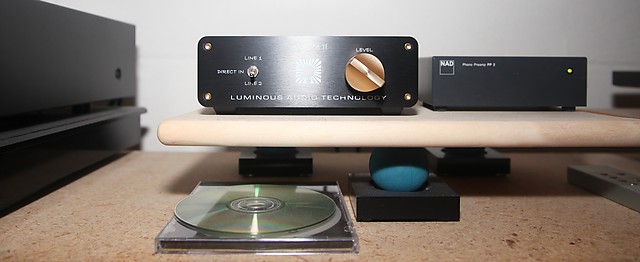
For those who aren’t aware, a passive preamp is primarily a volume control (and in this case, a source selector as well) that does not require electricity. It’s about as bare bones as it gets. No power cord. No warm-up time. No tubes. No capacitors. If you hold the position that when it comes to audio, less-is-more, then here’s your ticket. The thing basically acts as a limiter that simply limits the amount signal that passes through it from the source (CD Player, Turntable, etc.) onto the amplifier. So, if it simply limits the signal and is functioning without any electricity then it goes without saying that a passive preamp cannot apply any gain to the signal being fed to it as is done via a conventional, electrical preamp. This can be a good thing and a bad thing.
For the best performance, a passive preamp has to be tailor-made for the system in which it will be used. That said, in order to be a proper match, a passive preamp has to be customized to match the speakers’ sensitivity, the amps input impedance, the amps input sensitivity (mV), and the output volage of the sources. Upon ordering an Axiom from Luminous, this is all the information you need to supply before they can build your preamp. Should you get a different amp or speakers or CD player, or all three, you can send your Axiom back to Luminous and they’ll re-adjust the gain ratio for $35.
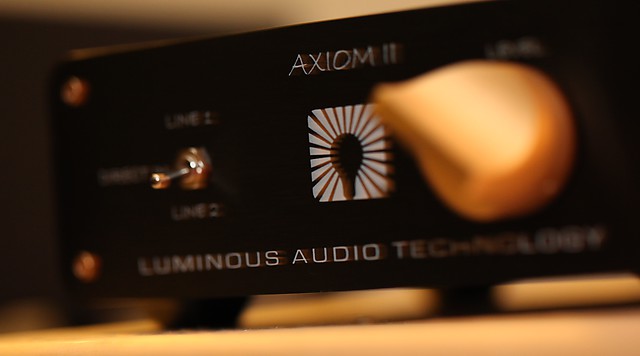
The Axiom takes the simplicity of the passive preamp a step further than simply eliminating electricity from the equation. From the Luminous website, “…the audio signal does not actually flow through the volume control. The signal flows through one high quality resistor and the amplifier’s inputs are shunted to ground via the AXIOM II’S ALPS potentiometer (Custom 1% stepped control in the Walker-mod version). The variable shunt technology allows control over the volume without the signal flowing through the actual volume pot that most audiophiles know is the weakest link in most preamp circuits. The degree in which the pot “allows” signal into the amplifier is simply what allows the customer control over his/her volume.” I’m no engineer but if I understand this correctly, it doesn’t get much simpler than this, short of having no preamp at all.
The original Axiom was a single input device. It had one set of RCA input plugs and one set of RCA output plugs and a single volume pot on the front. The chassis was about the size of a box of wooden matches. Having the option of plugging multiple sources into the Axiom would introduce a selector switch into the equation which would have detracted from the obvious simplicity of the device. This was one of my complaints of the original Axiom. I have multiple sources so had to switch input cables on the rear of the Axiom anytime I wanted to switch from listening to CDs to vinyl, and vice-versa. Not to mention, the gain ratio could only be set for one of the components. Tim Stinson at Luminous has cleverly addressed the problem with the Axiom II. Of the three inputs, one is a “direct in” that keeps the signal out of the way of the source selector switch. Depending on the values of your other two sources, you may have conflicting issues. “…the new AXIOM II with multiple inputs may or may not offer three inputs in all systems. Dependent upon the output impedance of your direct source when turned off, you may be forced into only 2 inputs, or unplugging the direct device when not in use. I.e., the output impedance of your CD player will be in parallel with the other source you have chosen. If the CD player is turned off, it may go to infinity (or still a very high/desirable value) or it may literally short the outputs therefore not allowing any sound on any input. Worst-case scenario the customer will still have at least two inputs from which to choose and the “mechanically switchable” direct input. This will require testing via ohmmeter or just simple experimentation (if the main source is affected the sound, it will be very lifeless and kill the volume of the other sources). If the direct source is making an effect, it will be VERY noticeable.” That said, when I had my phono stage, my SACD player and my PS1 CD player all plugged into the Axiom II, I did have some issues – but I’ll get to that later.
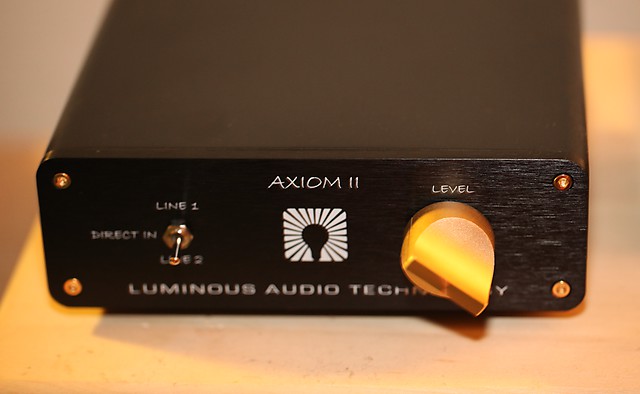
The aesthetics of the Axiom II are equally as simple as its design parameters. Though larger than the original Axiom (in order to accompany over twice as many rear-panel RCA plugs as well as a source selector switch on the front panel) the Axiom II is a really small and light-weight component. It measures approximately 6.5” wide by 2.5” tall by 5.5” deep. Its chassis is a simple black box with a classy gold volume pot and white silk screened logo.
The Axiom II came to me broken-in, but I found it open up a bit more within the first 20 hours of use. Improvements had definitely been made based on my memory of listening to the original Axiom. I liked listening to the original Axiom but found it to sound as its name suggested – passive. Not a lot of punch or gusto. Bass characteristics left something to be desired. Furthermore, as someone who consistently switches between multiple components in their system, I found cable swapping cumbersome and inconvenient. These were the negatives. The positives: I thought the presentation was musical and easy to listen to. Those same positive qualities were present, and then some, with the Axiom II – given the right circumstances.
First, I noticed that whichever component was plugged into the “direct in” sounded the best. There was more presence, better bass and better definition and transparency across the entire frequency spectrum. The presentation was simply more musical and effortless. Via either of the other two inputs, the presentation quality was lowered a notch or two. The decrease in sound quality was comparable to going from a well-recorded, uncompressed file and then listening to it at 320 kbps. I just became more aware that I was listening to recorded music. Also, via the non “direct in” inputs, imaging became a bit confused and voices that are typically smack dab in the middle of the speakers took a step or two to the right. This has me constantly leaning my head to the left to try and correct the problem. Once I would plug the component that I was listening to back into the “direct in” – problem solved. Matter of fact, once there, imaging and soundstaging were as good and effortless as I have heard in my system – and leaps and bounds above how I remember the original Axiom performing.
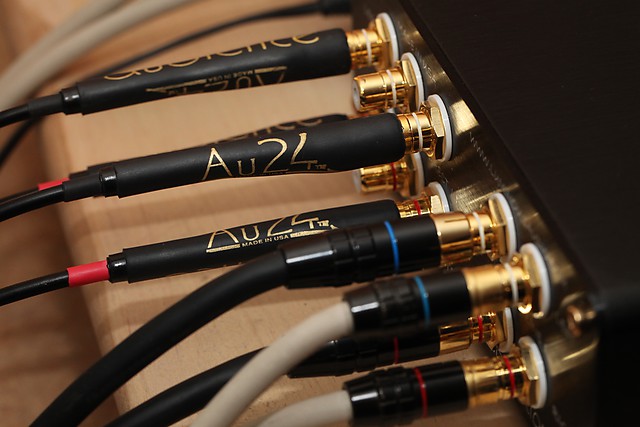
Bass response was also significantly better than I remember the Axiom I sounding. It was solid and taut and, perhaps more telling, reflective of the component that was playing. My tried and true Sony PS1 has slightly rolled-off, soft sounding bass characteristics whereas my Sony SCD-CE595 has more defined bass. Via the Axiom II and its “direct in” RCA inputs, these characteristics (as well as all the characteristics that separate the two disc-spinners) were more apparent than I have ever heard in my system. That said, unlike lesser mid-fi components that add gobs of bass to whatever is played on them, the Axiom only reported what was on the disc. If there wasn’t a lot of bass on the recording, it showed via the Axiom. For some reason, I have been listening to The Beastie Boys Hello Nasty a lot lately and the Axiom portrayed the dizzying effects and varying degrees of (oftentimes plentiful) bass with ease. Also, unlike other lesser components, I didn’t feel like the Axiom lent itself to one type of music more than others. It did a fairly good job decoding whatever I threw at it.
However, nothing is perfect. As a single source preamp, I felt that the Axiom was a solid performer. The problem was when I introduced multiple sources into the equation as having more than one source plugged into the Axiom detracted too much from its performance to make it acceptable. And the ability to plug multiple sources in was what I was really going for here. Having to unplug cables and swap stuff around to listen to separate components on a preamp that is designed to accept up to 3 components doesn’t cut it with me. Especially when the thing is being touted as a no-compromise device that its designers claim can go toe to toe with any other preamp – regardless of price. Common sense would dictate that if you are willing to do all this cable swapping, you would save yourself a couple of hundred bucks and get the Axiom single-input version.
It was a number of years ago that I did the review of the first single-input Axiom. Based on my memory though, and what I wrote in that review, this new Axiom II definitely sounds better (as long as there is only one source component connected to it). How, or what they did to improve on such a simple device is a bit bewildering, but it does sound better. I don’t know in terms of basic sonic attributes if it beats my Bottlehead Foreplay though. There is something that the extra oomph of a preamp with gain gives you. Or maybe it’s the tubes. Or maybe it’s both. For lack of a better adjective, the Bottlehead (at least to my ears) has a tad bit more gusto. Music sounds slightly bigger and, well, louder. Bass is a tad bit more defined and a bit more controlled. And when I say a tad, I mean a tad. The review period for the Axiom II has been an unusually long one. I have had it in my system for months at a time and I don’t notice these things until I swap the Foreplay back in. I never felt that something was missing while the Axiom II was being used.
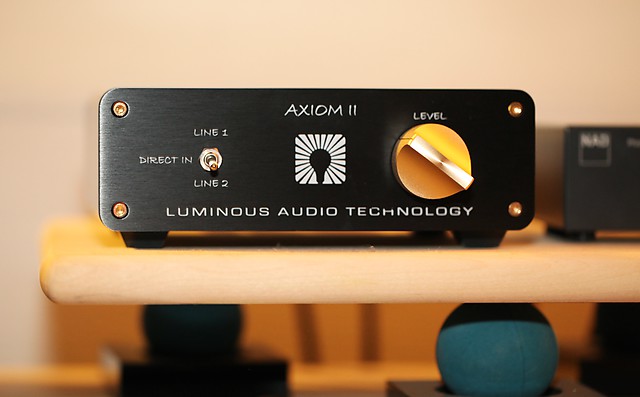
Of course I feel obliged to point out that the Axiom II wins hands down compared to the Foreplay for not being finicky to use. The Axiom II has no tubes to worry about, no power cord, no dual-mono volume pots, and no warm-up time. That last one is my favorite. I used the Axiom II exclusively with my AMC 2100 solid-state amp, which I leave on all the time. Coming home at 3:30 am and wanting to hear a little music before going to sleep was never out of the question. I’ll really miss that about the Axiom. That and the reliability of it. The ability to plug my PS1 into it and forget about it.
So, I guess when it’s all said and done, I don’t necessarily recommend this version of the Axiom II but rather its little brother – the single input version. How various components interact with each other via the Axiom II is contingent on their values. According to the Luminous Audio website, you may or may not have the same problems that I encountered and that’s based on your components’ values. I can’t stand behind the claim that it can beat out any other preamp, regardless of price, when you can’t even have all three of its source inputs in use. To me, that is one of the primary functions of a preamp. But if you have a single source or are willing to swap cables when you want to switch between sources, then I highly recommend the single-input Axiom II. This version starts at $195 which is a steal and should be highly considered if you are in the market for such a thing and fit the above stated description.
Review System:
- Pete Riggle Engineering and Audio String Theory “The Woody” Tonearm
- Zu/Denon DL-103 cartridge
- NAD PP-2 phono stage
- Sony PS1 CD player with PS Audio xStream Power Punch 7 power cord
- Sony SCD-CE595 SACD Player
- Bottlehead Foreplay line stage
- AMC CVT2030 amplifier
- Audience Au 24 speaker cables and interconnects
- Gingko Audio Cloud 14 and Mini Clouds vibration control
Manufacturer and pricing
- Luminous Audio Technology
- From $195 – see Axiom II Price Guide




Wow. Nice find. Nice review. Thanks.
How is your AMC 2030 holding up? I also have an Sony SCD CE-595. I ownwd the AMC amp for a couple of years.
Hi Thad, This unit was never designed to be a true “3 input unit.” It is a two input unit with a direct in if someone really wants to critically listen. If the source you use in the direct input has a super high impedance when turned off, you can get away with 3 ins. However, this is rare. We make a 3 input version sans the direct input now for those who truly need the third in. Same price! Tim S